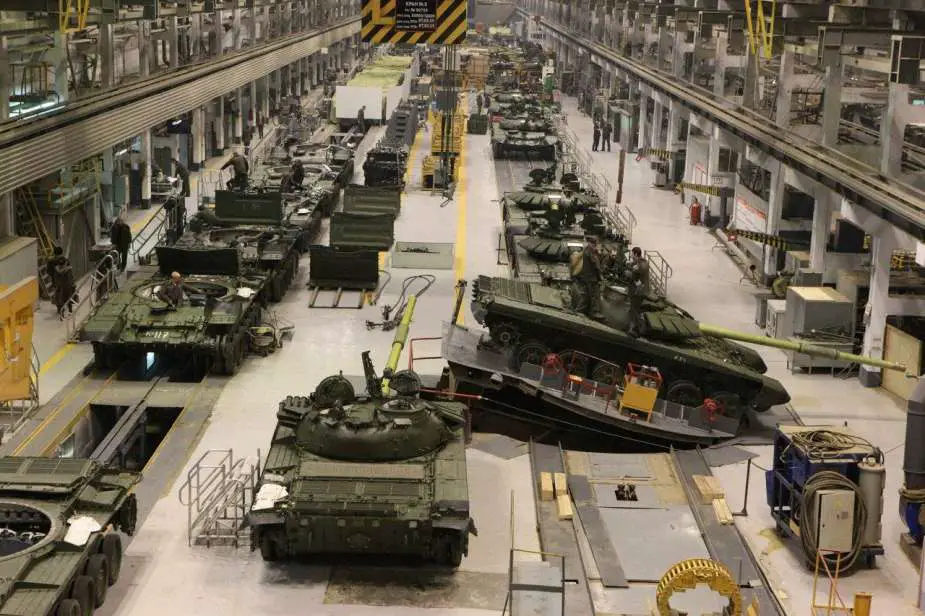Breaking news
Russia further increases defense budget and military complex in 2024.
Russia has planned a $45 billion increase in its military budget for 2024, despite international sanctions. This raises the question: how is Russia managing to increase its armament production? What measures has the Russian government put in place to develop its defense industry, and what are the impacts on Russia's economic future?
Follow Army Recognition on Google News at this link

A Russian factory producing main battle tanks (Picture source: Russian Media)
In 2024, the Russian economy is deeply engaged in the war effort in Ukraine, leading to a major restructuring of its budgetary and economic priorities. The Russian government has significantly increased its defense budget, now representing about 30% of total federal expenditures and 6% of GDP. This massive increase, around 70% more than the previous year, underscores the Kremlin's commitment to the conflict in Ukraine.
So how is Russia managing such a drastic increase in military equipment production, despite being the target of international sanctions?
Russia first considered introducing a six-day workweek without a salary increase. This proposal, coming from state-backed Russian business groups and relayed by the media, aims to increase workforce productivity and strengthen the Russian economy against the challenges posed by sanctions and the ongoing conflict.
The proposal followed a call from the Avanti business club, which includes Russian business leaders and several members of parliament. The club emphasized the need for additional investments in the country's "financial and economic system" to face crippling Western sanctions. This request comes in the context of a labor shortage in Russia, exacerbated by the exodus of citizens following the war in Ukraine and the partial mobilization announced in September 2022.
Russia has increased the production of certain types of military equipment, including older equipment. According to reports, this increased production includes tanks, armored vehicles, rocket launchers, and artillery, as well as Iskander short-range ballistic missiles, Pantsir medium-range surface-to-air missile systems, and hypersonic Kinzhal missiles. Although the total volume of weapons produced has not been detailed, the significant increase in production indicates a major effort to strengthen Russia's military capabilities against current challenges.
Furthermore, Russia has also removed a large number of Soviet-era military vehicles from its largest military equipment depots. These depots, such as the one in Vagzhanovo located in Eastern Siberia, had stored about 3,840 tanks and armored vehicles before the invasion of Ukraine in February 2022. However, about 2,600 of these vehicles remained on the site in November 2022, representing a decrease of more than 40% from the total observed before the war. The reduction in the number of vehicles at these depots suggests that Russia may have sent them to be refurbished with new parts and equipment, as part of its efforts to compensate for significant material losses in the conflict in Ukraine.
Russia has also increased the production of certain military hardware by more than tenfold. This significant increase in production suggests major adjustments in production capacities and industrial priorities. The exact methods used to increase this production have not been explicitly mentioned, but such a rise suggests considerable efforts in adapting production chains and allocating resources.
But despite all these measures and the increase in the defense budget, Russia still faces major challenges. The Russian economy, although showing some resilience against Western sanctions, is facing increasing imbalances. The increased dependence on the military-industrial complex is causing distortions in other economic sectors. International sanctions continue to weigh, particularly by increasing the costs of military equipment. Despite these challenges, the Russian government maintains the war in Ukraine as an absolute priority, indicating its willingness to bear the associated economic and social costs.
Meanwhile, Russia faces logistical and technological challenges. The defense industry, despite increased funding, is limited in its ability to rapidly increase production due to complex value chains and rigid industrial processes. Moreover, Russia is isolated internationally, relying mainly on relations with countries like North Korea and Iran for its military support.
In contrast, Ukraine, despite a lower military budget than Russia, manages to keep pace thanks to substantial support from its Western allies. The United States and other NATO countries provide significant military aid, including advanced defense systems and logistical assistance, which compensates for the gaps in terms of weapon production and military spending. This external assistance is crucial for Ukraine, allowing it to maintain a strong position against the Russian offensive. However, this aid seems to be diminishing over time due to the vagaries of politics, and Ukraine must develop its own arms industry and minimize its dependence on international aid.
The Russian economy in 2024 is characterized by a refocusing on the war effort, with significant economic and social implications. The increased funding of the defense sector, despite technological challenges and international sanctions, demonstrates Russia's determination to continue the conflict in Ukraine. On the other hand, Ukraine, supported by military and logistical aid from its allies, continues to resist despite more limited resources.

























